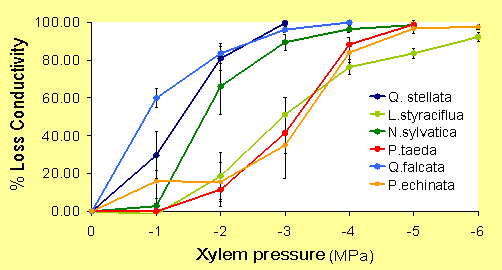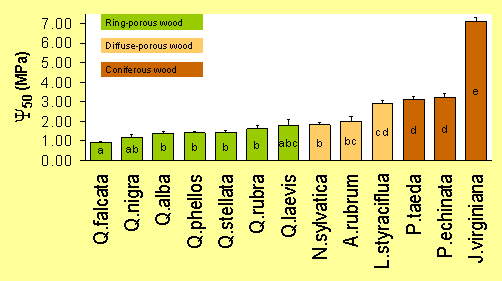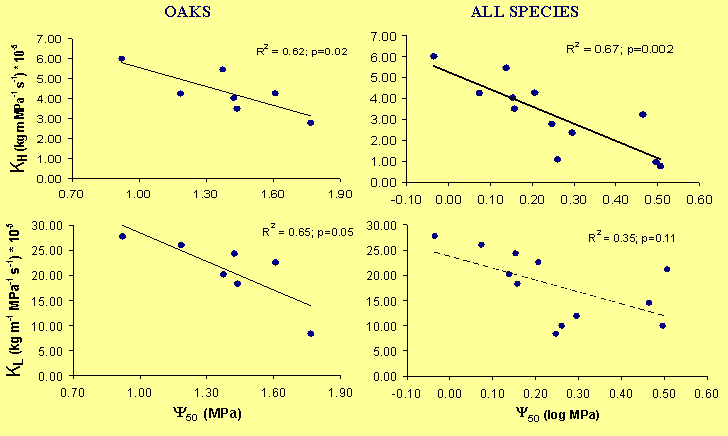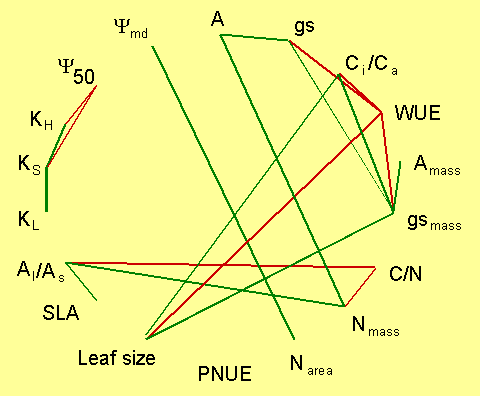 The response to decreasing pressure differed between species and functional groups (vulnerability curves of two species of each group). 
|

|

|
AbstractThe vulnerability of xylem to cavitation plays a significant role in the hydraulic function of plants. Resistance to cavitation has been considered a major character involved in drought tolerance. We determined whether variation in cavitation vulnerability for a set of woody species was accompanied by a trade-off with other water transport and physiological traits. We evaluated the relationship between vulnerability to cavitation, expressed as the xylem tension at which 50% of conductivity was lost (Y50), saturated hydraulic conductivity (KH), stem-specific hydraulic conductivity (Ks) and leaf-specific hydraulic conductivity (KL) for 13 woody species (including seven oaks) of Central North Carolina. Relationships with other plant traits (specific leaf area, leaf nitrogen, photosynthesis and stomatal conductance) were also examined. Y50 varied from –0.92 to –7.12 MPa. Among the species, oaks (ring-porous wood) were the most vulnerable (mean Y50= -1.39 MPa) followed by diffuse-porous species (mean Y50= -2.24 MPa), and conifers (mean Y50 of 3.17 for pines and 7.12 MPa for eastern red cedar). Within the oaks, the association between Y50 and KH was strong (r2=0.62), and also strong between Y50 and KL (r2=0.65). There was evidence of a negative association between Y50 and KH (r2=0.67) across all species (excluding eastern red cedar). These findings, particularly those within Quercus, provide evidence of a trade-off between vulnerability to cavitation and hydraulic properties, suggesting that the evolution of increased resistance to xylem cavitation is associated with decreased hydraulic conductivity. |
IntroductionXylem hydraulic properties are important for the general function of plants as they exert a strong influence on water transport and therefore on the potential for carbon uptake (Zimmermann 1983). The occurrence air-emboli (cavitation) limits water transport. Resistance to cavitation therefore may be advantageous for drought-tolerant species. However, there may be trade-offs with other physiological traits. Objectives
|
MethodsStudy sites: Duke Forest-Durham, NC and Sandhills-Fort Bragg, NC Vulnerability to cavitation: The loss of hydraulic conductivity with decreasing xylem pressure was measured for six stems of each species using the centrifugal force method (Alder et al. 1997). Percent loss of conductivity (PLC=100(1-Kh/Kmax) was plotted against xylem pressure (vulnerability curve) Field data: Midday leaf water potential measured with a pressure chamber and gas exchange data collected with a Li-cor 6400 between 9.00-12.00h on each day. Statistical analysis: Vulnerability curves were fitted with an exponential sigmoidal function (PLC=100/(1+exp(a(Y-b)))) (Pammenter and Willigen 1998). Trade-offs evaluated with regression analysis. Both using S-Plus 2000 for Windows. Correlagram based on Pearson correlation using SPSS 10 for Windows Field measurements were determined for all species except Quercus laevis and Pinus echinata during the summer of 2000 |
Table 1 - Physiological traits
| Ymd, Midday water potential (MPa) | gs, Stomatal conductance (mol m-2 s-1) |
| Y50, Estimated value of xylem tension at 50% loss in conductivity | Ci/Ca, Intercellular-Ambient CO2 concentration ratio |
| KH, Saturated hydraulic conductivity (kg m MPa-1 s-1) | WUE, Water use-efficiency (mmol mol-1) |
| Ks, Stem-specific hydraulic conductivity (kg m-1 MPa-1 s-1) | Amass, Photosynthesis-mass based (mmol g-1 m-2 s-1) |
| KL, leaf-specific hydraulic conductivity (kg m-1 MPa-1 s-1) | gsmass, conductance-mass based (mol g-1 m-2 s-1) |
| Al/As, Leaf-stem area ratio | C/N, Carbon-Nitrogen ratio |
| Leaf size (cm2) | Nmass, Nitrogen content-mass based (g g-1) |
| SLA, Specific Leaf Area (cm2/g) | Narea, Nitrogen content-area based (g m-2) |
| A, Photosynthesis (mmol m-2 s-1) | PNUE, Photosynthetic nitrogen use-efficiency (mmol g-1 s-1) |
 The response to decreasing pressure differed between species and functional groups (vulnerability curves of two species of each group). 
|

|

|
Conclusions
|
Alder, N. N., W. T. Pockman, J. S. Sperry, and Nuismer S. 1997. Use of centrifugal force in the study of xylem cavitation. Journal of Experimental Botany 48: 665-674
Pammenter, N. W., and Vander Willigen, C. 1998. A mathematical and statistical
analysis of the curves illustrating vulnerability of xylem to cavitation.
Tree Physiology 18: 589-593
Zimmermann M. H. 1983. Xylem Structure and the Ascent of Sap. Springer-Verlag. Berlin
We thank B. Beecham, M. Brinkley, and W. Cook for their assistance. This study was funded by a FCT-PRAXIS XXI Doctoral Fellowship to CFM and NSF funds to RBJ.
This poster was presented at the 2001 Ecological Society of America meeting.
Current Projects | Jackson Lab home
Last modified 30 August 2001